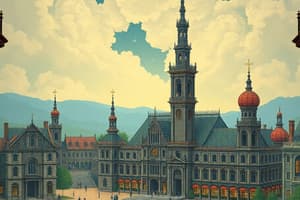Podcast
Questions and Answers
Which of the following explorers is known for conquering the Aztec Empire?
Which of the following explorers is known for conquering the Aztec Empire?
- Cortez (correct)
- Bartolome Diaz
- Prince Henry the Navigator
- Pizarro
The Treaty of Tordesillas divided the New World between Spain and Portugal.
The Treaty of Tordesillas divided the New World between Spain and Portugal.
True (A)
What economic factor pushed younger sons to seek opportunities abroad during the Age of Exploration?
What economic factor pushed younger sons to seek opportunities abroad during the Age of Exploration?
Primogeniture laws
The main product exported from South Asia during the Age of Exploration was _____
The main product exported from South Asia during the Age of Exploration was _____
Match the following regions with their corresponding major exports:
Match the following regions with their corresponding major exports:
What technological advancement was NOT mentioned as being adopted by Europeans for sailing?
What technological advancement was NOT mentioned as being adopted by Europeans for sailing?
Who is known as the Portuguese royal figure that mapped the African coast?
Who is known as the Portuguese royal figure that mapped the African coast?
Male exploration negatively impacted women's rights during the Age of Exploration.
Male exploration negatively impacted women's rights during the Age of Exploration.
Flashcards
Age of Exploration
Age of Exploration
A period of European exploration and expansion, particularly to the Americas, from roughly the 15th century onwards.
European Expansion
European Expansion
European countries' increasing control over territories and trade routes in the Americas, Asia, and Africa.
Technological Advancements
Technological Advancements
New technologies (like the astrolabe, compass and improved ships) that helped Europeans explore and conquer.
European Motivations
European Motivations
Signup and view all the flashcards
Treaty of Tordesillas
Treaty of Tordesillas
Signup and view all the flashcards
Portuguese Trading Post Empire
Portuguese Trading Post Empire
Signup and view all the flashcards
Omani-European Rivalry
Omani-European Rivalry
Signup and view all the flashcards
Columbian Exchange
Columbian Exchange
Signup and view all the flashcards
Study Notes
Age of Exploration: European Expansion
- New World Discovery: Exploration led to the discovery and colonization of the Americas (North, Central, and South America).
- European Empires: Multiple European nations (Portuguese, Dutch, French, Spanish, etc.) and non-European powers (Manchu, Ottomans, Russians, Aztec) were involved in expansion throughout this time period.
- Key Explorers: Bartolome Diaz, Cortes, and Pizarro were prominent explorers of the period.
Technological Advancements
- European Innovations: Europeans adopted and improved technologies like the astrolabe, compass, rudders, and chainsaws for navigation and shipbuilding.
- Shipbuilding: Ship design from Arab and East Asian cultures was adapted for faster, stronger ships with larger hulls, better suited for navigating monsoon and hurricane seasons.
- Cartography: Advances in cartography, driven by the Scientific Revolution, created improved maps with more accurate knowledge of geography, including gravity, water depths, and tidal patterns.
Economic and Social Dynamics
- European Motivations: European motivations for exploration included jobs, resources, wealth, and the pursuit of economic advancement, alongside the practice of slavery.
- Primogeniture Laws: Primogeniture laws (where the eldest son inherited property) pushed younger sons to seek opportunities abroad.
- Religious Migration: The Protestant Reformation spurred religious migration, with Protestants leaving Spain and Catholics leaving England.
European Trade and Colonization
- Shifting Trade Patterns: Direct trade with Asia replaced indirect trade.
- Indian Ocean Trade: Portugal established a vast network of trading posts through the Indian Ocean while competing with Oman.
- New World Focus: Spain concentrated its resources in Central and South America, while Portugal focused on Brazil due to the Treaty of Tordesillas.
- Diverse Involvement: Great Britain, France, and the Netherlands (or Dutch) also participated in colonization efforts, engaging in the Indian Ocean trade later and the New World at different points in time.
Impact on Gender Roles
- Increased Rights: Male exploration, initially without female involvement, led to increased rights for women in Europe, Asia, and Southeast Asia, including land ownership and business opportunities.
Major Exports
- Americas: Sugar, tobacco, and rum were significant exports
- Africa: Enslaved people were major part of the export trade
- South Asia: Cotton was a key export.
- East Asia: Porcelain, silk, and luxury goods were valued exports.
Key Figures and Events
- Prince Henry the Navigator: A Portuguese figure who mapped and established trading posts along Africa’s western coast.
- Importance of Gravity: Understanding tidal and wind patterns was essential for navigation.
Wind Patterns and Sailing
- Indian Ocean: Seasonal monsoon winds.
- Atlantic Ocean: Fixed year-round wind patterns (north: west to east; south: east to west).
- Triangular Trade: Trade routes involved the Americas, Europe, and Africa. This reflected wind-pattern sailing characteristics.
Ship Development
- Specialized Ships: New European ships, like Carracks and Caravels, were designed for trade, not warfare, and featured speed to evade pirates.
Cultural and Religious Diffusion
- Expansion: Trade, technology, religion, and gunpowder spread rapidly across the globe.
- Christianity in the Americas: Christianity spread into the Americas through forced conversion efforts.
- Islam in Asia: Islam spread throughout parts of East and Southeast Asia.
- Gunpowder: The widespread use of gunpowder enhanced European power by increasing their technological advantage.
Studying That Suits You
Use AI to generate personalized quizzes and flashcards to suit your learning preferences.




